Summary (English)
In 2002, the staff of the Archaeological Museum in Zadar excavated test trenches on a cadastral parcel no. 1941/24 in Caska and found the remains of three walls from the Roman period. During 2005, archaeological excavations began at the initiative of the owner. The research was conducted from October 28 to November 29 and began with geodetic and Ground Penetrating Radar (GPR) surveys that covered most of the land plot of about 480 m2. GPR survey indicated zones with a higher concentration of solid materials and linear structures, so test archaeological trenches were placed at these locations to confirm the existence of archaeological remains. Trench 1 was excavated to a depth of 150 cm, and at trench 2 an average depth of 80 to 100 cm was reached, while the total excavated area is 320 m2. In these trenches, the following archaeological remains were discovered: remains of stone and brick walls bound with mortar (total length 62.5 m) from two architectural phases; the remains of large vessels – dolia: three large (about 160 cm in diameter) and one smaller (80 cm in diameter), intended for the storage of cereals or other food products; the remains of a latter floor that overlaid the older phase; intact remains of an infrastructure canal (10.8 m long and 1.2 m wide for water supply or sewerage) built of stone slabs bounded with mortar; and archaeological artefacts: pottery, tegulae, metal objects, coins, glass, animal bones, shells, snails.
The archaeological remains unearthed are parts of a complex from the Roman period which, according to current data, existed from the end of the 1st to the middle of the 3rd century. Among the excavated structures, it is possible to distinguish two construction phases. The economic purpose of the complex was confirmed for the first phase of the site by the finds of built-in ceramic vessels (dolia). The purpose of the complex during the second phase cannot yet be more precisely defined. Within the complex, there was a well-preserved infrastructure channel. The span of ceramic tableware ranges from luxurious terra sigillata and terra nigra to coarse, black-and-grey thick-walled kitchen pottery. These are mostly standard forms of pottery for everyday usage, i.e. cups, jugs, bowls and plates. Fragments of two amphorae were found, three oil lamps, one of them with the FORTIS stamp, tegula with the PLOC stamp and a large number of sherds of indeterminate pottery. Five pieces of bronze coins, a bronze hook, a bronze fibula, iron shackles and lead plates were found among the metal objects. The glass fragments belong to small jugs, a long-necked bottle and a glass, while other pieces are too small for determination (G. Skelac 2006, Hrvatski arheološki godišnjak 2/2005, 281–283).
- Goran Skelac
Director
- Goran Skelac
Team
Research Body
- Geoarheo d.o.o.
Funding Body
- Grad Novalja






![Download [PDF]](/excavation/skins/fasti/images/results/download_sml.png)

